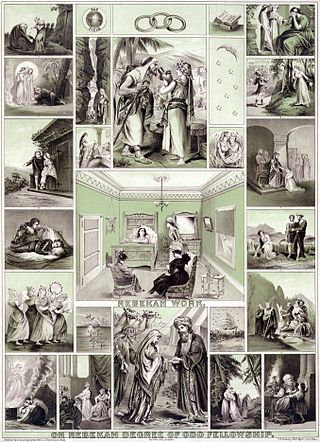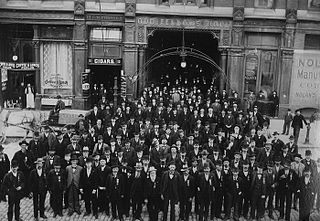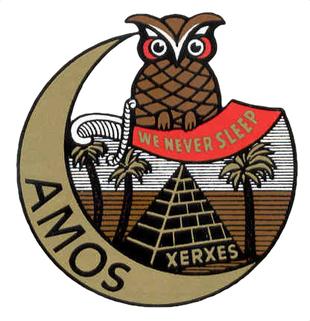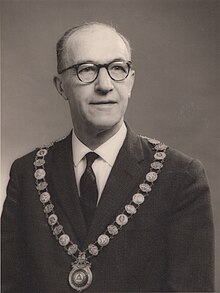
The Improved Order of Red Men is a fraternal organization established in North America in 1834. It claims direct descent from the colonial era Sons of Liberty. Their rituals and regalia are modeled after those assumed by men of the era to be used by Native Americans. Despite the name, the order was formed solely by, and for, white men. This whites-only rule was part of their bylaws until 1974, when the all-white clause was eliminated. Their current position is that they are now open to people of all ethnic backgrounds. In 1935 the organization claimed a membership of about half a million, but it has now declined to a little more than 15,000.

The Independent Order of Odd Fellows (IOOF) is a non-political, non-sectarian international fraternal order of Odd Fellowship. It was founded in 1819 by Thomas Wildey in Baltimore, Maryland, United States. Evolving from the Order of Odd Fellows founded in England during the 18th century, the IOOF was originally chartered by the Independent Order of Oddfellows Manchester Unity in England but has operated as an independent organization since 1842, although it maintains an inter-fraternal relationship with the English Order. The order is also known as the Triple Link Fraternity, referring to the order's "Triple Links" symbol, alluding to its motto "Friendship, Love and Truth".

The Knights of Honor, was a fraternal order and secret society in the United States in the late 19th and early 20th century. The Knights were one of the most successful fraternal beneficiary societies of its time.

Fraternal Order of Eagles (F.O.E.) is a fraternal organization that was founded on February 6, 1898, in Seattle, Washington, by a group of six theater owners including John Cort, brothers John W. and Tim J. Considine, Harry (H.L.) Leavitt, Mose Goldsmith and Arthur Williams. Originally made up of those engaged in one way or another in the performing arts, the Eagles grew and claimed credit for establishing the Mother's Day holiday in the United States as well as the "impetus for Social Security" in the United States. Their lodges are known as "aeries".

A benefit society, fraternal benefit society, fraternal benefit order, friendly society, or mutual aid society is a society, an organization or a voluntary association formed to provide mutual aid, benefit, for instance insurance for relief from sundry difficulties. Such organizations may be formally organized with charters and established customs, or may arise ad hoc to meet unique needs of a particular time and place.

The International Organisation of Good Templars, whose international body is known as Movendi International, is a fraternal organization which is part of the temperance movement, promoting abstinence from alcohol and other drugs.

The Daughters of Rebekah, also known as the Rebekahs and the International Association of Rebekah Assemblies, is an international service-oriented organization and a branch of the Independent Order of Odd Fellows. As the Independent Order of Odd Fellows, the Rebekahs began as an all-white organization, typical at the time, that purported to promote reciprocity and charity, and drew inspiration from Judeo-Christian ethics.
A fraternal order is a fraternity organised as an order, with traits alluding to religious, chivalric or pseudo-chivalric orders, guilds, or secret societies. Contemporary fraternal orders typically have secular purposes, including social, cultural and mutually beneficial or charitable aims. Many friendly societies, benefit societies and mutual organisations take the form of a fraternal order.
The Order of Scottish Clans was a fraternal and benevolent society The dual purpose of the Order was to provide life and disability insurance to Scottish immigrants and their descendants, and also to preserve the culture and traditions of Scotland among Americans of Scottish ancestry.
The International Order of Twelve Knights and Daughters of Tabor is an African-American fraternal organization best known as the sponsor of the Taborian Hospital.

The Ancient Order of United Workmen (AOUW) was a fraternal organization in the United States and Canada, providing mutual social and financial support after the American Civil War. It was the first of the "fraternal benefit societies", organizations that would offer insurance as well as sickness, accident, death and burial policies.

The Imperial Order of Muscovites was an unofficial, unrecognized appendant body to the Independent Order of Odd Fellows in the United States, founded in 1894 in Cincinnati, Ohio, and lasting until about 1921.

The Order of the Sons of Hermann (German: Der Orden der Hermanns-Soehne, also known as Hermann Sons, is a mutual aid society for German immigrants that was formed in New York, New York, on July 20, 1840, and remains active in the states of California, Ohio, and Texas today. Open to members of any heritage today, the order provides low-cost insurance and mutual aid and has historically promoted the preservation of the German language and traditions.
The Order of Royal Purple was the female auxiliary of the Elks of Canada. Unlike their counterparts in the United States, who have never been officially recognized by the Benevolent and Protective Order of Elks, the OORP was officially recognized by the Elks of Canada.

The Ancient Mystic Order of Samaritans (AMOS) is an unofficial appendant body of all Odd Fellows It is recognized as the "playground for Odd Fellowship" and is known for engaging in public and private hijinks and spectacle, all in the name of good, clean fun. AMOS is open to male Odd Fellows in good standing over the age of 18 but has a close relationship with Ladies of the Orient ("LOTO"), which is only open to women. The two organizations typically meet at the same time and share in social events with each other. Like many other primarily social appendant bodies to fraternal organizations, the rituals and initiations of AMOS have a Middle-Eastern theme and the official regalia is a fez.












